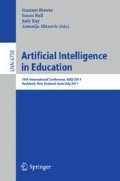Abstract
Multimodal approaches are increasingly used for affect detection. This paper proposes a model for the fusion of physiological signal that measure learners’ heart activity and their facial expressions to detect learners’ affective states while students interact with an Intelligent Tutoring System (ITS). It studies machine learning and fusion techniques that classify the system’s automated feedback from the individual channels and their feature level fusion. It also evaluates the classification performance of fusion models in multimodal systems, identifying the effects of fusion over the individual modalities.
Access this chapter
Tax calculation will be finalised at checkout
Purchases are for personal use only
References
D’Mello, S., Graesser, A.: Multimodal semi-automated affect detection from conversational cues, gross body language, and facial features. User Modeling and User-Adapted Interaction 20, 147–187 (2010)
Sebe, N., Cohen, I., Gevers, T., Huang, T.S.: Multimodal approaches for emotion recognition: a survey. In: Proc. SPIE, vol. 5670, pp. 56–67 (2005)
Calvo, R.A., D’Mello, S.: Affect Detection: An Interdisciplinary Review of Models, Methods, and their Applications. IEEE Transactions on Affective Computing 1, 18–37 (2010)
Holmes, N.P., Spence, C.: Multisensory integration: space, time and superadditivity. Current Biology 15, 762–764 (2005)
Aghaei Pour, P., Hussain, M., AlZoubi, O., D’Mello, S., Calvo, R.: The Impact of System Feedback on Learners’ Affective and Physiological States. In: Aleven, V., Kay, J., Mostow, J. (eds.) ITS 2010. LNCS, vol. 6094, pp. 264–273. Springer, Heidelberg (2010)
Graesser, A.C., Chipman, P., Haynes, B.C., Olney, A.: AutoTutor: An intelligent tutoring system with mixed-initiative dialogue. IEEE Transactions on Education 48, 612–618 (2005)
Author information
Authors and Affiliations
Editor information
Editors and Affiliations
Rights and permissions
Copyright information
© 2011 Springer-Verlag Berlin Heidelberg
About this paper
Cite this paper
Hussain, M.S., Calvo, R.A. (2011). Multimodal Affect Detection from Physiological and Facial Features during ITS Interaction. In: Biswas, G., Bull, S., Kay, J., Mitrovic, A. (eds) Artificial Intelligence in Education. AIED 2011. Lecture Notes in Computer Science(), vol 6738. Springer, Berlin, Heidelberg. https://doi.org/10.1007/978-3-642-21869-9_73
Download citation
DOI: https://doi.org/10.1007/978-3-642-21869-9_73
Publisher Name: Springer, Berlin, Heidelberg
Print ISBN: 978-3-642-21868-2
Online ISBN: 978-3-642-21869-9
eBook Packages: Computer ScienceComputer Science (R0)

